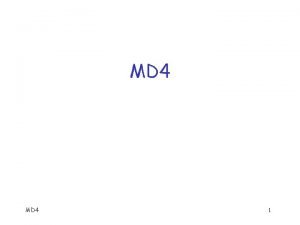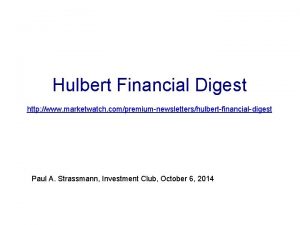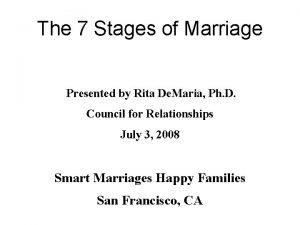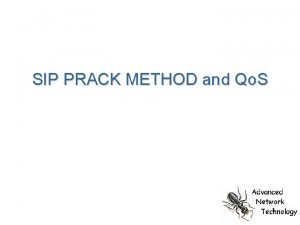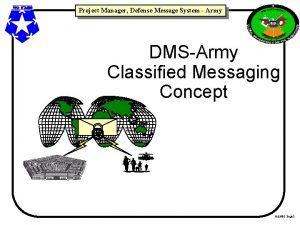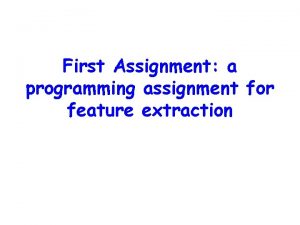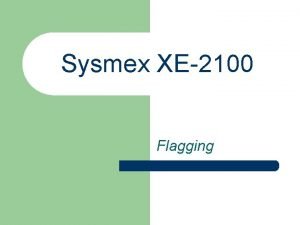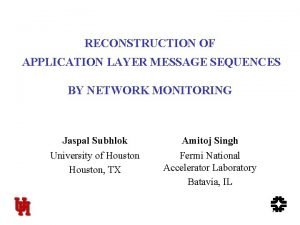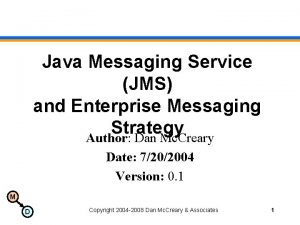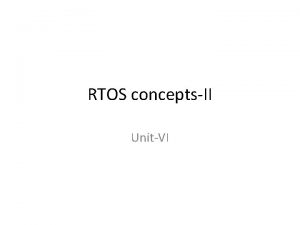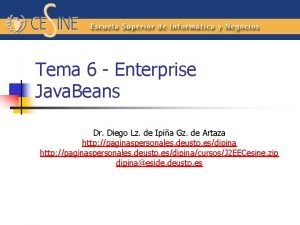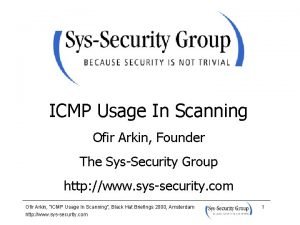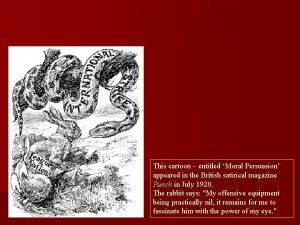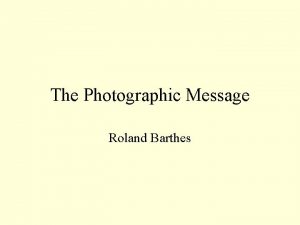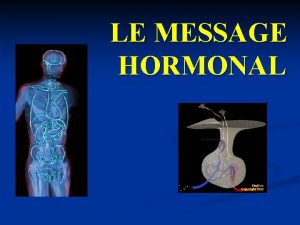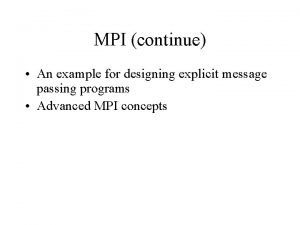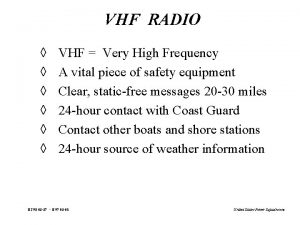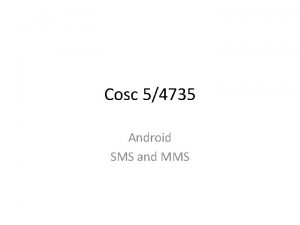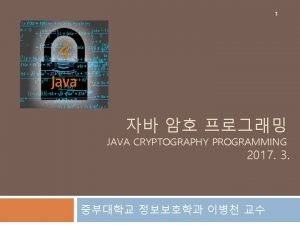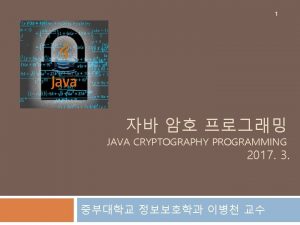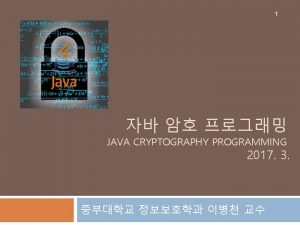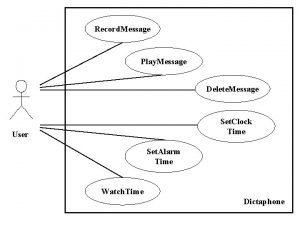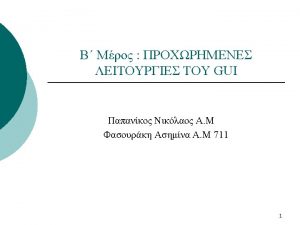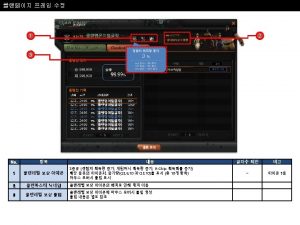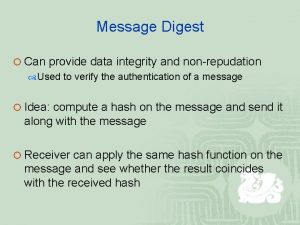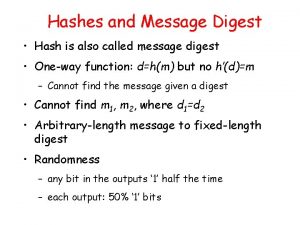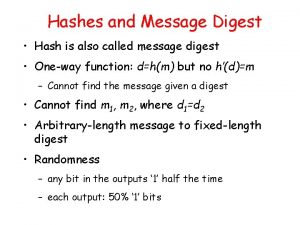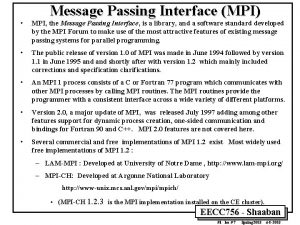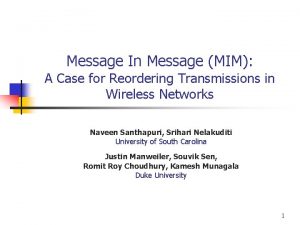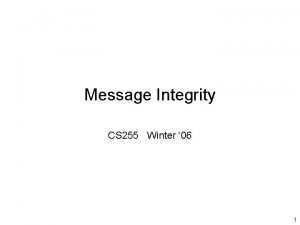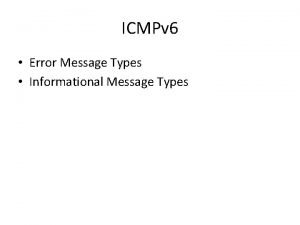MD 5 1 MD 5 Message Digest 5







































































- Slides: 71

MD 5 1

MD 5 Message Digest 5 q Strengthened version of MD 4 q Significant differences from MD 4 are q o o o MD 5 4 rounds, 64 steps (MD 4 has 3 rounds, 48 steps) Unique additive constant each step Round function less symmetric than MD 4 Each step adds result of previous step Order that input words accessed varies more Shift amounts in each round are “optimized” 2

MD 5 Algorithm For 32 -bit words A, B, C, define F(A, B, C) = (A B) ( A C) G(A, B, C) = (A C) (B C) H(A, B, C) = A B C I(A, B, C) = B (A C) q Where , , , are AND, OR, NOT, XOR, respectively q Note that G “less symmetric” than in MD 4 q MD 5 3

MD 5 Algorithm MD 5 4

MD 5 Algorithm Round 0: Steps 0 thru 15, uses F function q Round 1: Steps 16 thru 31, uses G function q Round 2: Steps 32 thru 47, uses H function q Round 3: Steps 48 thru 63, uses I function q MD 5 5

MD 5: One Step q Where MD 5 6

MD 5 Notation q Let MD 5 i…j(A, B, C, D, M) be steps i thru j o “Initial value” (A, B, C, D) at i, message M q Note that MD 50… 63(IV, M) h(M) o Due to padding and final transformation q Let f(IV, M) = (Q 60, Q 63, Q 62, Q 61) + IV o Where “+” is addition mod 232 per 32 -bit word q Then f is the MD 5 compression function MD 5 7

MD 5 Compression Function q Let M = (M 0, M 1), each Mi is 512 bits q Then h(M) = f(f(IV, M 0), M 1) o Assuming M includes padding q That is, f(IV, M 0) acts as “IV” for M 1 o Can be extended to any number of Mi q Merkle-Damgard construction o Used in MD 4 and many hash functions MD 5 8

MD 5 Attack: History q Dobbertin “almost” able to break MD 5 using his MD 4 attack (ca 1996) o Showed that MD 5 might be vulnerable q In 2004, Wang published one MD 5 collision o No explanation of method was given q Based on one collision, Wang’s method was reverse engineered by Australian team o Ironically, this reverse engineering work has been primary source to improve Wang’s attack MD 5 9

MD 5 Attack: Overview q Determine two 1024 -bit messages o M = (M 0, M 1) and M = (M 0, M 1) q So that MD 5 hashes are the same o That is, a collision attack q Attack is efficient o Many improvements to Wang’s original approach q Note that o Each Mi and M i is a 512 -bit block o Each block is 16 words, 32 bits/word MD 5 10

MD 5 Attack: Overview q Determine two 1024 -bit messages o M = (M 0, M 1) and M = (M 0, M 1) q So that MD 5 hashes are the same o That is, a collision attack A differential cryptanalysis attack q Idea is to use first block to generate desired “IV” for 2 nd block q o Can be viewed as a “chosen IV” attack MD 5 11

A Precise Differential q Most differential attacks use XOR or modular subtraction for difference q These are not sufficient for MD 5 q Wang proposed o A “kind of precise differential” o More informative than XOR and modular subtraction combined MD 5 12

A Precise Differential q Consider bytes y = 00010101 and y = 00000101 z = 00100101 and z = 00010101 q Note that y y = z z = 00010000 = 24 Then wrt modular subtraction, these pairs are indistinguishable q In this case, XOR distinguishes the pairs q y y = 00010000 z z = 00110000 MD 5 13

A Precise Differential q Modular subtraction and XOR is not enough information! o Let y = (y 0, y 1, …, y 7) and y = (y 0, y 1, …, y 7) q Want to distinguish between, say, y 3=0, y 3=1 and y 3=1, y 3=0 q Use a signed difference, y o Denote y i=1, yi=0 as “+” o Denote y i=0, yi=1 as “ ” o Denote y i=yi as “. ” MD 5 14

A Precise Differential q Consider bytes z = 10100101 and z = 10010101 Then z is “. . +-. . ” q Note that both XOR and modular difference can be derived from z q Also note same given by pairs q x = 10100101 and x = 10010101 y = 10100101 and y = 10010101 MD 5 15

A Precise Differential Properties of Wang’s signed differential q More restrictive than XOR or modular difference q o Provides greater “control” during attack q But not too restrictive o Many pairs satisfy a given value q Ideal balance of control and freedom MD 5 16

Wang’s Attack q Next, we outline Wang’s attack o On part theory and one part computation o Overall attack splits into 4 steps More details follow q Then discuss reverse engineering of Wang’s attack q Finally, consider whether attack is a practical concern or not q MD 5 17

Wang’s Attack Somewhat ad hoc q Consider input and output differences q Input differences q o Applies to messages M and M o Use modular difference q Output differences o Applies to intermediate values, Q i and Qi o Use Wang’s signed difference MD 5 18

Wang vs Dobbertin q Dobbertin’s MD 4 attack o Input differentials specified o Equation solving is main part of attack q Wang’s MD 5 attack o o o MD 5 More of a “pure” differential attack Specify input differences Tabulate output differences Force some output differences to hold Unforced differences satisfied probabilistically 19

Wang’s Attack: Step 1 q Specify input differential pattern o Must “behave nicely” in later rounds o These differentials are given below o Modular difference used for inputs q Only need to specify M o Then M is determined by differential MD 5 20

Wang’s Attack: Step 2 q Specify o o o Must “behave nicely” in early rounds That is, easily satisfied in early rounds Restrictive signed difference used Most mysterious part of attack Wang used “intuitive” approach q Only MD 5 output differential pattern 1 such pattern known (Wang’s) 21

Wang’s Attack: Step 3 q Derive set of sufficient conditions o Using differential patterns q If these conditions are all met o Differential patterns hold o Therefore, we obtain a collision MD 5 22

Wang’s Attack: Step 4 Computational phase q Must find pair of 1024 -bit messages that satisfy all conditions in step 3 q o Messages: M = (M 0, M 1) and M = (M 0, M 1) Deterministically satisfy as many conditions as possible q Any remaining conditions must be satisfied probabilistically q o Number of such conditions gis expected work MD 5 23

Wang’s Attack: Step 4 q MD 5 Computational phase: a) Generate random 512 -bit M 0 b) Use single-step modification to force some conditions in early steps to hold c) Use multi-step modification to force some conditions in middle steps to hold d) Check all remaining conditions—if all hold then have desired M 0, else goto b) e) Follow similar procedure to find M 1 f) Compute M 0 and M 1 (easy) and collision! 24

Wang’s Attack: Work Factor Work is dominated by finding M 0 q Work determined by number of probabilistic conditions q o Work is on the order of 2 n where n is number of such conditions q Wang’s original attack: n > 40 o Hours on a supercomputer q Best as of today, about n = 32. 25 o Less than 2 minutes on a PC MD 5 25

Wang’s Differentials Input and output differentials q Notation: “+” over n for 2 n and “ ” for 2 n q o For example: Consider 2 -block message: h(M 0, M 1) q Notation: IV = (A, B, C, D) q Denote “IV” for M 1 as IV 1 (and IV 1 for M 1) q o Then IV 1 = (Q 60, Q 63, Q 62, Q 61) + (A, B, C, D) o Where Qi are outputs when hashing M 0 q Let h = h(M 0, M 1) and h = h(M 0, M 1) MD 5 26

Wang’s Input Differential q Required input differentials M 0 = (0, 0, 231, 0, 0, 0, 215, 0, 0, 231, 0) M 1 = (0, 0, 231, 0, 0, 0, 215, 0, 0, 231, 0) o Note: M 0 and M 0 differ only in words 4, 11 and 14 o Note: M 1 and M 1 differ only in words 4, 11 and 14 o Same differences except in word 11 q Also required that IV 1 = (231, 225 + 231) q Goal is to obtain h = h h = (0, 0, 0, 0) MD 5 27

Wang’s Output Differential Required output differentials q Part of M 0 differential table: q o o MD 5 Qi are outputs for M 0 Wj are input (modular) differences Output is output modular difference Output is output signed (“precise”) difference 28

Derivation of Differentials? q Where do differentials come from? o “Intuitive”, “done by hand”, etc. Input differences are fairly reasonable q Output differences are more mysterious q We briefly consider history of MD 5 attacks q Then reverse engineering of Wang’s method q o None of this is entirely satisfactory… MD 5 29

History of MD 5 Attacks q Dobbertin tried his MD 4 approach o Modular differences and equation solving o No true collision obtained, but did highlight potential weaknesses q Chabaud and Joux o Use XOR differences o Approximate nonlinearity by XOR (like in linear cryptanalysis) o Had success against SHA-0 MD 5 30

History of MD 5 Attacks q Wang’s attack o Modular differences for inputs o Signed differential for outputs o Gives more control over outputs and actual step functions, not approximations o Also, uses 2 blocks, so second block is essentially “chosen IV” attack q Wang’s magic lies in differential patterns o How were these chosen? MD 5 31

Daum’s Insight q Wang’s attack could be “expected” to work against MD-like hash with 3 rounds o Input differential forces last round conditions o Single-step modification forces 1 st round o Multi-step modifications forces 2 nd round But MD 5 has 4 rounds! q A special property of MD 5 is exploited: q o Output difference of 231 “propagated from step to step with probability 1 in the 3 rd round and with probability 1/2” in most of 4 th round MD 5 32

Wang’s Differentials No known method for automatically generating useful MD 5 differentials q Daum: build tree of difference patterns q o Include both input and output differences o Prune low probability paths from tree o Connect “inner collisions”, etc. q However, Wang’s differentials are only useful ones known today MD 5 33

Reverse Engineering Wang’s Attack Based on 1 published MD 5 collision q Computed intermediate values q Examined modular, XOR, signed difference q Uncovered many aspects of attack q Resulted in computational improvements q Overall, an impressive piece of work! q MD 5 34

Conditions q For first round, define Tj = F(Qj 1, Qj 2, Qj 3) + Qj 4 + Kj + Wj Rj = Tj <<< sj Qj = Qj 1 + Rj q Initial values: (Q 4, Q 3, Q 2, Q 1) q This is equivalent to previous notation MD 5 35

Conditions Let be modular difference: X = X X q Then Tj = Fj 1 + Qj 4 + Wj Rj ≈ ( Tj) <<< sj Qj = Qj 1 + Rj q Where Fj = F(Qj, Qj 1, Qj 2) F(Q j, Q j 1, Q j 2) q The Rj equation holds with high probability q Tabulated Qj, Fj, Tj, and Rj for all j q MD 5 36

Conditions Derive conditions on Tj and Qj that ensure known differential path holds q Conditions on Tj not used in original attack q o More efficient recent attacks do use these q Goal is to deterministically (or with high prob) satisfy as many conditions as possible o Reduces number of iterations needed MD 5 37

T Conditions Recall Tj = Fj 1 + Qj 4 + Wj Rj ≈ ( Tj) <<< sj q Interaction of “ ” and “<<<” is tricky q Suppose T = 220 and T = 219 and s = 10 q Then ( T) <<< s = (T T) <<< s = 229 and (T <<< s) = 229 q In this example, “ ” and “<<<” commute q MD 5 38

T Conditions q Spse q Then T = 222, T = 221 + 220 + 219, s = 10 ( T) <<< s = (T T) <<< s = 229 but (T <<< s) = 229 + 1 q Here, “ ” and “<<<” do not commute q Negative numbers can be tricky MD 5 39

T Conditions If T and s are specified, conditions on T are implied by R = ( T) <<< s q Can always force a “wrap around” in R q o Can be little bit tricky due to non-commuting Recall Tj = F(Qj 1, Qj 2, Qj 3) + Qj 4 + Kj + Wj q Given M, conditions on Tj can be checked q Better yet, want to select M so that many of the required T conditions hold q MD 5 40

T Conditions: Example q At step 5 of Wang’s collision: T 5 = 219 + 211, Q 4 = 26, Q 5 = 231 + 223 26, s 5 = 12 Since Qj = Qj 1 + Rj, it is easy to show that R 5 = Q 5 Q 4 = 231 + 223 q We also have R 5 ≈ ( T 5) <<< s 5 q Implies conditions on any T 5 that satisfies Wang’s differentials! q MD 5 41

T Conditions: Example From the previous slide: R 5 = 231 + 223 = ( T 5) <<< 12 q Of course, the known T 5 works: T 5 = 219 + 211 q But, for example, T 5 = 220 219 + 211, does not work, since rotation would “wrap around” q Implies there can be no 220 term in T 5 q o Complex condition to restrict borrows also needed q Bottom line: Can derive a set of conditions on Ts that ensure Wang’s differential path holds MD 5 42

Output Conditions q Easier to check Q conditions than T o The Q are known as “outputs” o Actually, intermediate values in algorithm q Much easier to specify M so that Q conditions hold than T conditions q In attacks, Q conditions mostly used MD 5 43

Output Conditions Use signed differential, X q For example, if X = 0 x 02000020 and X = 0 x 80000000 then X is denoted “-. . . +. . . ” q Also we must analyze round function: F(A, B, C) = (A B) ( A C) q Bits of A choose between bits of B and C q MD 5 44

Output Conditions: Example q At step 4 of Wang’s collision: Q 2 = Q 3 = 0, Q 4 = 26, F 4 = 219 + 211 q From Q 4 we have: Q 4 = 1 9 and Q 4 = 0 10… 25 q Note MD 5 that Q 4 = Q 4 at all other bits 45

Output Conditions: Example q From Q 4 we have: Q 4 = 1 9 and Q 4 = 0 10… 25 Note that Q 4 = Q 4 at all other bits q Bits 9, 10, …, 25 are “constant” bits of Q 4 q All others are “non-constant” bits of Q 4 q On constant bits, Q 4 = Q 4 and on nonconstant bits, Q 4 q MD 5 46

Output Conditions: Example Consider constant bits of Q 4 q Since F 4 = F(Q 4, Q 3, Q 2), from defn of F q o If Q 4 = 1 j then F 4 = Q 3 j and F 4 = Q 3 j o If Q 4 = 0 j then F 4 = Q 2 j and F 4 = Q 2 j q q Then F 4 = F 4 j for each constant bit j From table, constant bits of Q 4 are constant bits of F 4 so no conditions on Q 4 MD 5 47

Output Conditions: Example Consider non-constant bits of Q 4 q Since F 4 = F(Q 4, Q 3, Q 2), from defn of F q o If Q 4 = 1 j then F 4 = Q 3 j and F 4 = Q 2 j o If Q 4 = 0 j then F 4 = Q 2 j and F 4 = Q 3 j Note that on bits 10, 11, 13, …, 19, 21, …, 25 F 4 = F 4, Q 4 = 1, Q 4 = 0 F 4 = Q 2, F 4 = Q 3 q Since Q 3 = Q 3 we have Q 3 = Q 2 10, 11, 13… 19, 21, , , 25 q MD 5 48

Output Conditions: Example q Still need to consider bits 9, 12, 20 o See textbook q From step 4, we derive the following output conditions: Q 4 = 0 10, , , 25, Q 4 = 1 9 Q 3 = 1 12, 20 Q 2 = 0 12, 20, Q 2 = Q 3 10, 11, 13… 19, 21, , , 25 MD 5 49

Conditions: Bottom Line q By reverse engineering one collision… o Able to deduce output conditions q If all of these are satisfied, we will obtain a collision q This analysis resulted in much more efficient implementations q All base on one known collision! MD 5 50

Single-Step and Multi-Step Modifications Given conditions, how can we use them? q That is, how can we make them hold? q Two techniques are used: q Single-step modifications q o Easy way to force many output conditions q Multi-step modifications o Complex way to force a few more conditions MD 5 51

Single-Step Modification q Select M 0 = (X 0, X 1, …, X 15) at random q Note that Wi = Xi for i = 0, 1, …, 15 q Also, IV = (Q 4, Q 1, Q 2, Q 3) q Compute outputs Q 0, Q 1, …, Q 15 o For each Qi, modify corresponding Wi so that required output conditions hold o This is easy—example on next slides MD 5 52

Single-Step Modification Suppose Q 0 and Q 1 are done q Consider Q 2 where Q 2 = Q 1 + (f 1 + Q 2 + W 2 + K 2) <<< s 2 q o Recall that “<<<” is left rotation o Recall fi = F(Qi, Qi 1, Qi 2) for i = 0, 1, …, 15 q Required conditions: Q 2 = 0 12, 20, 25 o This means bits 12, 20 and 25 of Q 2 must be 0 (bits numbered left-to-right from 0 to 31) o No restriction on any other bits of Q 2 q We can modify W 2 so condition on Q 2 holds MD 5 53

Single-Step Modification For Q 2 we want Q 2 = 0 12, 20, 25 q Compute Q 2 = Q 1 + (f 1 + Q 2 + W 2 + K 2) <<< s 2 q o Denote bits of Q 2 as (q 0, q 1, q 2, …, q 31) q Let Ei be 32 -bit word with bit i set to 1 o All other bits of Ei are 0 Let D = q 12 E 12 q 20 E 20 q 25 E 25 q Let Q 2 = Q 2 + D q Replace W 2 with W 2 = ((Q 2 Q 1) >>> s 2) f 1 Q 2 K 2 q Then conditions on Q 2 all hold q MD 5 54

Single-Step Mod: Summary q Modify words of message M 0 o Alternatively, select Q 0, Q 1, …, Q 15 so conditions satisfied, then compute corresponding M 0 All output conditions steps 0 to 15 satisfied q Suppose c conditions remain unsatisfied q o Then after 2 c iterations, expect to find M 0 that satisfies all output conditions q Most output conditions are in first 16 steps o Single-step mods provide a shortcut attack o But we can do better… MD 5 55

Multi-Step Modification q Want to force some output conditions beyond step 15 to hold q Tricky, since we must maintain all conditions satisfied in previous steps o And we already modified all input words q Many multi-step mod techniques o We discuss the simplest MD 5 56

Multi-Step Modification Let M 0 = (X 0, X 1, …, X 15) be M 0 after singlestep mods q Want Q 16 = 0 0 to hold q First, single-step modification: D = q 0 E 0 and Q 16 = Q 16 + D and W 16 = ((Q 16 Q 15) >>> s 16) f 15 Q 12 K 16 q Note that W 16 = X 1 q And X 1 used to compute Qi for i=1, 2, 3, 4, 5 q o Don’t want to change any Qi in rounds 0 thru 15 MD 5 57

Multi-Step Modification q Compute W 16 = ((Q 16 Q 15) >>> s 16) f 15 Q 12 K 16 Where W 16 = X 1 q Problem with Qi for i=1, 2, 3, 4, 5 q o No conditions on Q 1, so it’s no problem Let Z = Q 0 + (f 0 + Q 3 + X 1 + K 1) <<< s 1 q Then Z is new Q 1, which is OK q Do “single-step mods” for i=2, 3, 4, 5 q MD 5 58

Multi-Step Modification Have Z = Q 0 + (f 0 + Q 3 + X 1 + K 1) <<< s 1 q Note that Z is new Q 1 q Do “single-step mods” for i=2, 3, 4, 5 X 2 = ((Q 2 Z) >>> s 2) f 1(Z, Q 0, Q 1) Q 2 K 2 X 3 = ((Q 3 Q 2) >>> s 3) f 2(Q 2, Z, Q 0) Q 1 K 3 X 4 = ((Q 4 Q 3) >>> s 4) f 3(Q 3, Q 2, Z) Q 0 K 4 X 5 = ((Q 5 Q 4) >>> s 5) f 4(Q 4, Q 3, Q 2) Z K 5 q Then all conditions on Qi, i=0, 1, …, 15, still hold q MD 5 59

Multi-Step Mods: Summary Many different multi-step mods q Ad hoc way to satisfy output conditions q o Care needed to maintain prior conditions Some multi-step mods only hold probabilistically q Multi-step mods have probably been taken about as far as possible q o Further improvements, incremental at best q Best implementation: 2 minutes/collision MD 5 60

Stevens’ Implementation Best implementation of Wang’s attack q About 2 minutes per collision on PC q Finding M 0 is most costly (shown here) q Algorithm for M 1 is similar q MD 5 61

A Practical Attack? q Wang’s attack is very restrictive o Generates “meaningless” collisions o Not feasible for meaningful collision q Is attack a real-world threat? q In some cases, meaningless collisions can cause problems o We illustrate such a scenario MD 5 62

A Practical Attack q Consider 2 letters, “written” in postscript: rec. ps q auth. ps Suppose the file rec. ps signed by Alice o That is, S = [h(rec. ps)]Alice q If h(auth. ps) = h(rec. ps), signature broken MD 5 63

A Practical Attack q Amazingly, h(auth. ps) = h(rec. ps) q And Wang’s attack was used q How is this possible? q Postscript has conditional statement: (X)(Y)eq{T 0}{T 1}ifelse q If X == Y then T 0 is processed; else T 1 is processed MD 5 64

A Practical Attack Postscript statement: (X)(Y)eq{T 0}{T 1}ifelse q How to take advantage of this? q Add spaces, so that postscript file begins with exactly one 512 -bit block q o Call this block W o Last byte of W is “(” in (X) q Let Z = MD 50… 63(IV, W) so that Z is output of compression function applied to W MD 5 65

A Practical Attack Let Z = MD 50… 63(IV, W) q Use Wang’s attack as follows q Find collision: o 1024 -bit M and M with M M and h(M) = h(M ) q o Where IV is Z instead of standard IV Wang’s attack easily modified to work for any non-standard IV q Now what? q MD 5 66

A Practical Attack Consider …(X)(Y)eq{T 0}{T 1}ifelse q q o o o Note that “…(” is W Let T 0 = postscript for “rec” letter Let T 1 = postscript for “auth” letter Let L = …(M)(M)eq{T 0}{T 1}ifelse Let L = …(M )(M)eq{T 0}{T 1}ifelse Then h(L) = h(L ) since o h(W, M) = h(W, M ) o h(A) = h(B) implies h(A, C) = h(B, C) for any C q File L displays T 0 and file L displays T 1 MD 5 67

A Practical Attack q File L = rec. ps q First block: W q. X block: M q. Y block: M q Display MD 5 “rec” 68

A Practical Attack q File L = auth. ps q First block: W q. X block: M q. Y block: M q Display MD 5 “auth” 69

A Practical Attack Bottom Line: A meaningless collision is a potential security problem q Of course, anyone who looks at the file would see that something is wrong q But, purpose of integrity check is to automatically detect problems q o How to automatically detect such problems? q This is a serious attack! o May also be possible for Word, PDF, etc. MD 5 70

Wang’s Attack: Bottom Line Extremely clever and technical q Computational aspects are well-understood q Theoretical aspects not well-understood q o Complex, difficult to analyze o Not well-explained by inventors o Must rely on reverse engineering No “meaningful” collisions are possible q But attack is a practical concern! q MD 5 is broken q MD 5 71
 Message digest 4
Message digest 4 Message digest java
Message digest java South forsyth high school ranking
South forsyth high school ranking Visual field digest
Visual field digest Job search digest
Job search digest Architectural digest n 156 ddl
Architectural digest n 156 ddl Risks digest
Risks digest Neb webcutter
Neb webcutter Webcutter2
Webcutter2 Visual field digest
Visual field digest Boat digest
Boat digest System 44 decodable digest
System 44 decodable digest Boat digest
Boat digest Fungi
Fungi Certificate for church elders
Certificate for church elders Hulbert financial digest rankings
Hulbert financial digest rankings Stages of marriage
Stages of marriage Visual field digest
Visual field digest Boat digest
Boat digest Poem about digestive system
Poem about digestive system Traffic digest
Traffic digest Sha-256-digest-manifest
Sha-256-digest-manifest Icra digest slide
Icra digest slide Visual field digest
Visual field digest Monica desai md
Monica desai md 1 corinthians 11 23 26 nkjv
1 corinthians 11 23 26 nkjv Neutral message
Neutral message Hf acars frequencies
Hf acars frequencies Sip invite flow
Sip invite flow It is the controlling idea or central insight of the story
It is the controlling idea or central insight of the story Defense message system
Defense message system 60000/1900
60000/1900 Execution styles in advertising
Execution styles in advertising Wbc ip message blasts/abn lympho
Wbc ip message blasts/abn lympho Micah 6:1-8 the message
Micah 6:1-8 the message A lydia
A lydia Application layer message
Application layer message Habakkuk message
Habakkuk message Java messaging services
Java messaging services Air message
Air message Good morning happy monday december
Good morning happy monday december Pipes in rtos
Pipes in rtos A message signed with blood to the nation of the cross
A message signed with blood to the nation of the cross Unset message diego
Unset message diego Smcr in communication
Smcr in communication Ofir arkin
Ofir arkin Eric blair biography
Eric blair biography Pgp message generation and reception
Pgp message generation and reception What is an example of an indirect-action message?
What is an example of an indirect-action message? Gap in the bridge political cartoon
Gap in the bridge political cartoon Main message
Main message League of nations rabbit and snake cartoon meaning
League of nations rabbit and snake cartoon meaning Photographic message
Photographic message Cipher based message authentication code
Cipher based message authentication code Generic creative style advertising example
Generic creative style advertising example What are the 15 parts of a business letter?
What are the 15 parts of a business letter? Acts 7 the message
Acts 7 the message Ipc message queue
Ipc message queue Central idea of a work of literature
Central idea of a work of literature Key message training
Key message training 1 timothy 1 12-17 the message
1 timothy 1 12-17 the message Persuasive message strategy body
Persuasive message strategy body Spineless leaders of democracy bedeutung
Spineless leaders of democracy bedeutung Example of persuasive messages in business communication
Example of persuasive messages in business communication Hypothalamus
Hypothalamus Psalm 32 the message
Psalm 32 the message Example of explicit message
Example of explicit message Akreditif lehdarı
Akreditif lehdarı Securite message example
Securite message example Mms from 4735
Mms from 4735 Matthew 13 the message
Matthew 13 the message John 14 message
John 14 message
